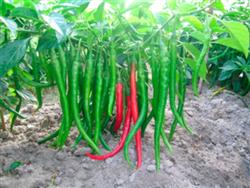How to control dead plants at seedling stage of pepper (sweet pepper)

The problem of dead chili plants is a great headache for vegetable farmers, especially in greenhouses where they have been cropped for more than three years, because there are not a few dead trees that lead to reduced or no yield. At present, it is the critical period of pepper seedling transplanting, and it is also the key link to prevent and control dead plants. the effect of preventing dead trees at this key point is much better than that of root irrigation in full fruit. the cost is more than 50% lower and the loss is much smaller. There are many causes leading to the death of pepper trees, in addition to fertilizer burning roots, water retting roots, seedling blight, stem rot, root rot are the main causes of dead plants, these diseases are collectively referred to as soil-borne diseases. In production, there are some single diseases and some compound diseases, among which root rot is the main cause of death. There are many kinds of pepper root rot, including Phytophthora root rot, Pythium root rot and Fusarium root rot. When the three root rot diseases occur at the same time, single chemical control is difficult to be effective. The bacteria sources of all these soil-borne diseases come from disease residues, water flow and unclean organic manure. The bacteria survive the winter in the soil, and when the temperature and humidity are appropriate, they will infect and spread pepper hosts and cause dead plants. These bacteria survive in the soil for a long time, and accumulate in the soil year by year with continuous cropping, so the phenomenon of dead trees is particularly serious in the greenhouse where continuous cropping for many years. At present, there are the following methods to control dead pepper plants: 1. Soil fumigation and disinfection; even if the soil is treated with methyl bromide or methanolone or Weibai mu, it is characterized by thorough sterilization and disinfection, but the operation is complex, high cost and takes a long time. 2, hot water hot soil disinfection; most foreign countries use this method, because the cost is too high, it is not suitable for our current national conditions. 3. The method of adding calcium cyanide in the greenhouse at high temperature is simple and easy, the cost is low, but the germicidal effect is poor. 4. The method of microbial agent: the effect of stubble land in new soil is good, but the effect of continuous stubble in old greenhouse is not ideal. 5, grafting technology; using wild pepper as rootstock grafting, the control effect can reach more than 95%, the technology with broad prospects, but the current technical operation is difficult and the cost is high. 6. Conventional chemical treatment, that is, Ammiao is used to collect 1 bag of water per bucket plus 50 grams of Jinlei, when transplanting, first dip in the seedling plate, then spray the hole with the same liquid, and then transplant, this method can ensure that the trees will not die before the first fruit period. To the full fruit stage, the root can be irrigated 1-2 times in the same way. The advantage of this method lies in its simplicity, good effect and low cost. It is very important to control dead pepper trees, catch "early" and take the initiative. The above methods for the prevention and control of dead hot pepper trees have their own advantages and disadvantages, and the situation varies from place to place, and measures should be taken according to the actual situation.
- Prev

How to remove the herbicide damage of chili?
The production of 1000 kg pepper requires 5.2kg of pure nitrogen, 1.2kg of phosphorus pentoxide and 6.5kg of potassium chloride. Before planting, 5000 kg of high-quality farm manure and 50 kg of phosphate fertilizer were applied per mu. The pepper began to be fertilized for the first time at the initial stage of expansion in order to promote fruit expansion. Apply 15-18 kg of pure nitrogen and 18-20 kg of phosphate fertilizer per mu.
- Next

Changing Seedling Raising Method to Cultivate Strong Seedling of Pepper
Greenhouse seedling can advance the marketing time of pepper and greatly increase economic benefits. In the process of seedling, there are several key steps that should not be ignored: (1) Select the seedling site. Select high dry terrain, sufficient sunshine, conducive to drainage, no continuous cropping, no pathogens to raise seedlings. (2) Strictly handle the seeds...
Related
- Where is it suitable to grow horseradish in China? it is expected to see the middle altitude horseradish in Alishan.
- How to prevent tomato virus disease reasonably? (Control methods included)
- Many people like to plant towel gourd on the balcony. What are the main points of this method and management?
- What crops can chili peppers be mixed with?
- Fertilization techniques and matters needing attention in Tomato
- What are the grafting techniques for peach seedlings in spring?
- Harm and control methods of root swelling disease of Chinese cabbage
- What are the pests of sweet potatoes? How to prevent and cure it?
- Symptoms, causes and Control methods of navel Rot in Tomato
- The cause of "Cucumber rotten bibcock" in Farmers' planting Cucumber and its Control Plan

